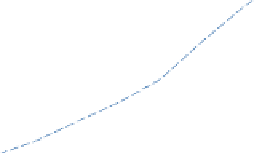Environmental Engineering Reference
In-Depth Information
SOME CLIMATE CHANGES AND IMPACTS OF NEXT FEW DECADES AND CENTURIES
FOR 1-4°C WARMING
RAIN
• 5-10% less rainfall
per degree
in Mediterranean, SW North America, southern Africa dry seasons
• 5-10% more rainfall
per degree
in Alaska and other high latitude NH areas
• 3-10% more heavy rain
per degree
in most land areas
RIVERS
• 5-10% less streamflow
per degree
in some river basins, including the Arkansas and Rio Grande
FOOD
• 5-15% reduced yield of US corn, African corn, and Indian wheat
per degree
SEA ICE
• 15% and 25% reductions in Arctic sea ice area
per degree
, in the annual average and September (respectively)
FOR 1-2°C WARMING
FIRE
• 200-400% increase in area burned
per degree
in parts of western US
FOR 3°C
COASTS
• Loss of about 250,000 square km of wetlands and drylands
• Many millions more people at risk of coastal flooding
EXTREMES
• About 9 out of 10 summer seasons expected to be warmer than all but
1 summer out of 20 in the last decades of the 20
th
century over
nearly all land areas
FOR 4°C
EXTREMES
• About 9 out of10 summers warmer than the warmest ever
experienced during the last decades of the 20
th
century over
nearly all land areas
FOR 5°C
FOOD
• Yield losses in most regions and
potential doubling of global grain
prices
1600
1400
Transient
Warming
Equilibrium
Warming
1200
1000
800
AND DAMAGE TO CORALS
AND SHELL-FORMING MARINE LIFE
DUE TO INCREASED ACIDITY AND WARMING
600
400
Stabilization
0
1
2
3
4
5
6
7
8
Global Average Warming (°C)
2°C
430 ppmv
(370-540)
3°C
540 ppmv
(440-760)
4°C
670 ppmv
(530-1060)
5°C
840 ppmv
(620-1490)
S TA B I L I Z AT I O N C O N C E N T R AT I O N
FIGURE S.5 Climate changes and climate impacts as a function of global warming (not in priority order or
implied importance). These anticipated effects are projected to occur in the 21st century following the tran-
sient warming for a given CO
2
equivalent concentration, followed by further warming to the equilibrium
value for stabilization at a given target concentration. As in previous figures, for discussion of transient and
equilibrium warming see Chapter 3, where it is noted that the probability distribution of climate sensitivity
is uncertain; larger or smaller warmings than the estimated likely value for a given carbon dioxide equiva-
lent concentration cannot be ruled out. Ranges are shown for climate impacts over the globe or over large
regions; specific regions, crops, river basins, etc. and their uncertainties are discussed in detail later in the
report. {3.2, 3.3, 4.2, 4.5, 4.6, 4.7, 4.8, 4.9, 5.1, 5.2, 5.3, 5.4, 5.7, 5.8}













































































































































































































